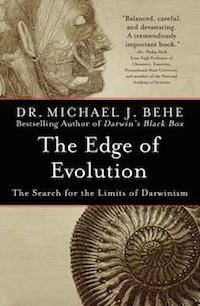 Evolution
Evolution
 Intelligent Design
Intelligent Design
The Edge of Evolution: Why Darwin’s Mechanism Is Self-Limiting

As we’ve discussed extensively here over the past week, a recent paper confirms a key inference I made in 2007 in The Edge of Evolution. Summers et al. 2014 conclude that “the minimum requirement for (low) [chloroquine] transport activity … is two mutations.” This is the last of my three posts on the matter. The first may be found here and the second here. Casey Luskin’s remarks are here.
 Looking down from an airplane at 30,000 feet, the landscape can appear pretty smooth. It can be hard to imagine yourself in the place of pioneers in covered wagons of earlier times, who had to slog over the uncleared ground bump by bump, facing rivers, ridges, and ravines. A lot of thinking about evolution over the years has been like looking down from a plane — imagining that an evolutionary trek from one large feature to another wouldn’t be too difficult, that it could even be made while blindfolded and drunk. But in reality life is lived on the ground and, without vision and sober planning, ditches, cliffs, and streams can be impassable.
Looking down from an airplane at 30,000 feet, the landscape can appear pretty smooth. It can be hard to imagine yourself in the place of pioneers in covered wagons of earlier times, who had to slog over the uncleared ground bump by bump, facing rivers, ridges, and ravines. A lot of thinking about evolution over the years has been like looking down from a plane — imagining that an evolutionary trek from one large feature to another wouldn’t be too difficult, that it could even be made while blindfolded and drunk. But in reality life is lived on the ground and, without vision and sober planning, ditches, cliffs, and streams can be impassable.
As science probes ever deeper into the molecular details of life, serious evolutionary thought has been forced to descend from 30,000 feet to ground level, and grave obstacles to undirected evolution have become manifest. Relatively recent, terrific research using the powerful techniques available to modern biology shows three general, separate barriers to a Darwinian (or, for that matter, to any undirected) evolutionary mechanism.
The first major barrier is random mutation itself. Because genomes code for many sophisticated molecular systems, random changes that have an effect will most frequently break or damage some already-functioning system. Nonetheless, breaking or diminishing subsystems of an exceedingly complex entity such as the cell can sometimes be adaptive — causing the degradation to spread, as Richard Lenski’s pioneering Long Term Evolution project has demonstrated so clearly. Other studies of degradative adaptation in nature strongly reinforce this point. (For example, see recent reports about loss-of-function genetic resistance to diabetes and heart disease in humans, gaitedness in horses, loss of cyanogenesis in clover, and a plethora of helpful broken genes in bacteria.
The second roadblock is actually natural selection. As Darwin envisioned, natural selection works relentlessly, honing a selected trait to fit its job more and more closely. The problem is that, the more selection hones a trait, the more specialized it becomes, and the more difficult then to use it for another complex purpose without prohibitively unlikely mutational modification. This has been nicely shown by the work of Joe Thornton’s group, where even very modest changes (the binding of a second, structurally similar steroid hormone to a homologous, structurally similar receptor protein) to a pre-existing system encountered strong, unexpected evolutionary obstacles.
The third obstacle is irreducible complexity, or the need to take multiple steps to reach a selected state. As I discussed in The Edge of Evolution and Summers et al. have now demonstrated experimentally, some selectable effects require more than one mutation before they kick in. When that’s the case the likelihood of reaching the state drops exponentially with each unselected step. Although special circumstances such as a very high mutation rate or population size can help get over one or a few such steps, those aren’t generally available. Even when they are, it doesn’t take many such steps to put the state well beyond the reach of random mutation.
This type of barrier is ubiquitous at the molecular level because new protein-protein interactions in general will require multiple mutational steps to attain (as I discussed at length in Edge and about which I rebutted criticisms on my blog), many of which will be unselected.
It’s important to notice that these three roadblocks are substantially independent of each other. Sequestration of a system to its current function by natural selection is a different problem from the damage done by adaptive-yet-degradative random mutations, both of which are conceptually distinct from the need for multiple, unselected steps to reach some adaptive states. A result of their independence is that they will work synergistically. Undirected evolutionary change faces multiple overpowering restraints.
UC Berkeley law professor emeritus Phillip Johnson once used an analogy for Darwinian evolution that I thought at the time was intriguing but unpersuasive. He pointed out that the same physical mechanism that causes a hot air balloon to rise in the sky prevents it from continuing up indefinitely. The mechanism of flight itself limits the balloon’s ascent — it will never get beyond Earth’s atmosphere.
Similarly, he offered, the Darwinian mechanism both permits and limits evolutionary change. In light of recent outstanding research, I’ve changed my mind — Johnson’s image is delightfully apposite. We see clearly at the detailed, molecular, ground level of life that Darwin’s mechanism is self-limiting. It can lift an evolutionary balloon so high but no higher, no matter how much hot air is blown into it.
